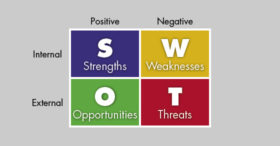Using a strengths, weaknesses, opportunities and threats (SWOT) analysis to frame an important business decision is a long-standing recommended practice. But don’t overlook other, broader uses that could serve your company well.
Performance factors
A SWOT analysis starts by spotlighting internal strengths and weaknesses that affect business performance. Strengths are competitive advantages or core competencies that generate value (and revenue), such as a strong sales force or exceptional quality.
Conversely, weaknesses are factors that limit a company’s performance. These are often revealed in a comparison with competitors. Examples might include a negative brand image because of a recent controversy or an inferior reputation for customer service.
Generally, the strengths and weaknesses of a business relate directly to customers’ needs and expectations. Each identified characteristic affects cash flow — and, therefore, business success — if customers perceive it as either a strength or weakness. A characteristic doesn’t really affect the company if customers don’t care about it.
External conditions
The next SWOT step is identifying opportunities and threats. Opportunities are favorable external conditions that could generate a worthwhile return if the business acts on them. Threats are external factors that could inhibit business performance.
When differentiating strengths from opportunities, or weaknesses from threats, the question is whether the issue would exist without the business. If the answer is yes, the issue is external to the company and, therefore, an opportunity or a threat. Examples include changes in demographics or government regulations.
Various applications
As mentioned, business owners can use SWOT to do more than just make an important decision. Other applications include:
Valuation. A SWOT analysis is a logical way to frame a discussion of business operations in a written valuation report. The analysis can serve as a powerful appendix to the report or a courtroom exhibit, providing tangible support for seemingly ambiguous, subjective assessments regarding risk and return.
In a valuation context, strengths and opportunities generate returns, which translate into increased cash flow projections. Strengths and opportunities can lower risk via higher pricing multiples or reduced cost of capital. Threats and weaknesses have the opposite effect.
Strategic planning. Businesses can repurpose the SWOT analysis section of a valuation report to spearhead strategic planning. They can build value by identifying ways to capitalize on opportunities with strengths or brainstorming ways to convert weaknesses into strengths or threats into opportunities. You can also conduct a SWOT analysis outside of a valuation context to accomplish these objectives.
Legal defense. Should you find yourself embroiled in a legal dispute, an attorney may want to frame trial or deposition questions in terms of a SWOT analysis. Attorneys sometimes use this approach to demonstrate that an expert witness truly understands the business — or, conversely, that the opposing expert doesn’t understand the subject company.
Tried and true
A SWOT analysis remains a useful way to break down and organize the many complexities surrounding a business. Our firm can help you with the tax, accounting and financial aspects of this approach.
© 2021 Covenant CPA

